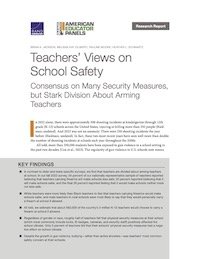By Brian A. Jackson, Melissa Kay Diliberti, Pauline Moore, Heather L. Schwartz
Shooting incidents at kindergarten through grade 12 (K–12) schools in the United States, including mass attacks like the one that killed 19 students and two teachers at Robb Elementary School in Uvalde, Texas, have sparked calls to increase security or adopt altogether new approaches to school safety. These approaches include allowing teachers or staff to carry firearms in some schools. To learn what teachers across the United States think about school safety generally and about specific proposals to enhance safety in schools, such as teacher-carry policies, RAND researchers administered a survey to a randomly sampled set of 973 K–12 teachers using the American Teacher Panel. The survey focused on teachers' views of safety in their schools, including their main safety concerns, perceptions of security measures in place, the effect of those measures on school climate, and whether they were concerned for their own safety and that of their students. On the specific issue of firearms in school, the survey asked whether allowing teachers to carry firearms would make schools more or less safe and whether teachers would personally carry a firearm if given the choice to do so. Findings note that teachers, like the U.S. population as a whole, are divided about armed teachers at school: Fifty-four percent of respondents reported believing that teachers carrying firearms will make schools less safe, 20 percent reported believing that it will make schools safer, and the final 26 percent reported feeling that it would make schools neither more nor less safe.
Key Findings
Similar to older and state-specific surveys, this survey found that teachers are divided about arming teachers at school. Fifty-four percent of the nationally representative sample of teachers reported believing that teachers carrying firearms will make schools less safe, 20 percent reported believing that it will make schools safer, and the final 26 percent reported feeling that it would make schools neither more nor less safe.
White teachers were more likely than Black teachers to feel that teachers carrying firearms would make schools safer, and male teachers in rural schools were most likely to say that they would personally carry a firearm at school if allowed.
All told, about 550,000 of the country's 3 million K–12 teachers would choose to carry a firearm at school if allowed.
Regardless of gender or race, roughly half of teachers felt that physical security measures at their school (which most commonly include locks, ID badges, cameras, and security staff) positively affected the school climate. Only 5 percent of teachers felt that their schools' physical security measures had a negative effect on school climate.
Despite the growth in gun violence, bullying — rather than active shooters — was teachers' most common safety concern.
Recommendations
Study early adopter schools or school districts that have more-expansive versions of teacher-carry programs to understand how they work in practice.
Conduct a comprehensive cost-benefit analysis of programs allowing teacher-carry to rigorously assess their outcomes.
Develop risk analysis approaches to inform school safety and security planning that balance frequent, lower-level forms of school violence, such as bullying, and lower-probability, extreme forms of school violence, such as shootings.
Develop a deeper understanding of the sources of teachers' safety concerns.
Identify how fears of victimization and of specific safety concerns contribute to teacher and principal turnover, and to student enrollment, attendance, and academic performance.
Better characterize the combined effects of school security measures and strategies on safety, school climate, and student attendance and academic performance.
Take the pulse of parents, teachers, administrators, and students about school safety measures to disaggregate by type of community and to triangulate their views on school safety.
Santa Monica, CA: RAND, 2023.
Download




